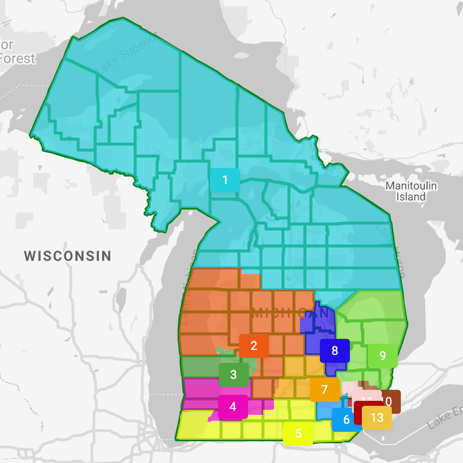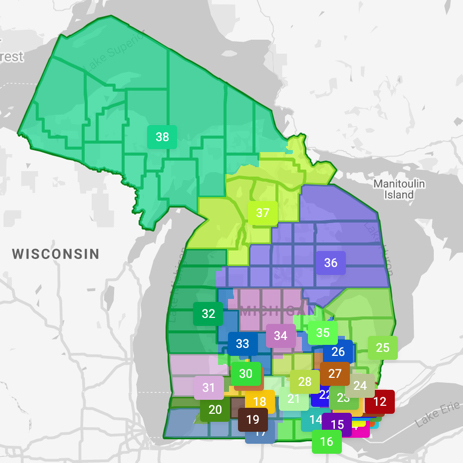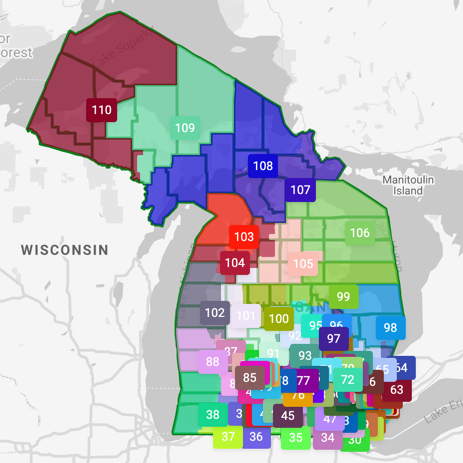Proposal 18-2, authored and championed by Voters Not Politicians, established the Michigan Independent Citizens Redistricting Commission (MICRC), which relies on everyday citizens to draw the political maps for Congress, the Michigan State Senate, and the Michigan State House every ten years. The entire process is constitutionally required to be fair, impartial, and transparent.
The Latest: In December 2023, a federal court ordered the MICRC to adopt new maps for State House districts 1, 7, 8, 10, 11, 12 and 14, and State Senate districts 1, 3, 6, 8, 10, and 11, after finding that these districts had been drawn heavily based on race, in violation of the Equal Protections Clause of the US Constitution. The MICRC successfully concluded the redraw of the voided State House districts in late February and the State Senate districts in July.
Throughout the redraw process, Voters Not Politicians has consistently maintained our faith in the constitutional amendment we designed and in the voters who support independent redistricting. And now the process that everyday Michiganders developed and voted into our constitution has proven its resilience by successfully producing two new electoral maps that will represent the people of Michigan for the next six years.
On July 30, 2024, Voters Not Politicians hosted a webinar to accompany the release of a joint report with MGGG Redistricting Lab evaluating the first cycle of the Michigan Independent Citizens Redistricting Commission. You can view the recording of that webinar here and download the most recent version of the report here.



On November 6, 2018, 61% of Michigan voters from across the state and across the political spectrum passed Proposal 2, a constitutional amendment to put the power to draw our election district maps in the hands of the voters — not politicians.
Proposal 2 was put on the ballot through a citizen-led ballot initiative. Voters Not Politicians volunteers collected more than 425,000 petition signatures from registered voters in every Michigan county with an all-volunteer effort.
Voters Not Politicians survived legal challenges that went all the way up to the Michigan Supreme Court to keep Proposal 2 on the ballot. Volunteers spread the word to vote “Yes on 2” across the state, knocking more than 460,000 doors, talking to voters at fairs and festivals, and more.
We had a number of endorsements, including former Democratic President Barack Obama and Republican California Governor Arnold Schwarzenegger.
On Election Day, 67 of Michigan’s 83 counties voted “Yes on 2,” with more than 2.5 million voters supporting a fair, impartial, and transparent redistricting process.
Michigan voters have access to a direct form of democracy called ballot initiatives. A ballot initiative is a way for citizens to bring about a public vote on a proposed statute or constitutional amendment by collecting a certain minimum number of petition signatures from registered voters.
Voters Not Politicians was required to collect 315,654 valid signatures in 180 days, to secure Proposal 2 a spot in the November 6, 2018 election. With a simple majority vote from the voters of Michigan, we amended Michigan’s constitution to place an Independent Citizens Redistricting Commission in charge of redistricting, ensuring that voters will choose their politicians, not the other way around.
On Tuesday, December 28th, 2021, Michigan’s Independent Citizens Redistricting Commission adopted new maps for Congress, State Senate, and State House. Each map passed with a constitutional majority of at least two Democrat, two Republican, and two Non-Affiliated commissioners. Their ability to rise above their political differences to meet their constitutional duty is a testament to their commitment to our democracy and an example of what people across the political spectrum can achieve when we work together to prioritize the will of voters – not politicians.
Before the redistricting reform amendment passed, the redistricting process in Michigan was rigged in favor of special interests.
Why? Because politicians and lobbyists met behind closed doors to draw Michigan’s election district maps to benefit themselves, not the voters. It’s called gerrymandering, and Michigan is currently home to some of the most gerrymandered districts.
Politicians met behind closed doors with lobbyists and highly paid consultants and used big data and advanced computer algorithms to pick the groups of voters most likely to help their party. This allowed politicians to manipulate elections to give them and their party an unfair advantage for the next decade of elections.
Proposal 18-2 ended this system and unrigged our maps.
Every 10 years, the US Census is conducted to measure how population shifts throughout the country. When this data is collected, states are required to redraw their voting district maps – a process called redistricting – to ensure equal population.
The term “gerrymandering” is used to describe the practice of drawing election district boundaries to favor one political party, incumbent, or candidate.
Instead of drawing lines to represent the voters’ interests, politicians meet behind closed doors with highly paid consultants and big data to carve and skew communities based on past voting patterns. Highly advanced computer programs help them predict how specific households will vote, which allows them to draw lines around voters to give themselves and their party an advantage in the next decade of elections.
Politicians must adhere to federal laws for equal population and minority representation, but are able to stretch and skew guidelines that are not enforceable. They don’t even have to prove that they’re following these guidelines.
Before the redistricting reform amendment passed, the redistricting process in Michigan was rigged in favor of special interests.
Why? Because politicians and lobbyists met behind closed doors to draw Michigan’s election district maps to benefit themselves, not the voters. It’s called gerrymandering, and Michigan is currently home to some of the most gerrymandered districts.
Politicians met behind closed doors with lobbyists and highly paid consultants and used big data and advanced computer algorithms to pick the groups of voters most likely to help their party. This allowed politicians to manipulate elections to give them and their party an unfair advantage for the next decade of elections.
Michigan voters exercised their right of direct democracy and put a constitutional amendment on the 2018 general election ballot, known as Proposal 2. Proposal 2 put the power to draw election district maps in the hands of voters and created a fair, impartial, and transparent process.
The amendment clearly defines who can participate in future redistricting processes, how the maps are drawn, and when the maps are drawn.
Click here to read the full amendment language.
Click here to view Implementation Archives from 2019 – 2021.
Voters Not Politicians is a 501(c)(4) organization dedicated to strengthening democracy in Michigan by engaging citizens in projects and initiatives across the state. Contributions made to Voters Not Politicians are not tax deductible for federal income tax purposes.
This website uses cookies. Voters Not Politicians uses cookies to understand how you interact with our site, improve performance, and provide a better experience for visitors like you. We may also use cookies to analyze traffic and share information with trusted third-party services.
By continuing to use this site, you consent to our use of cookies as described in our Privacy Policy.